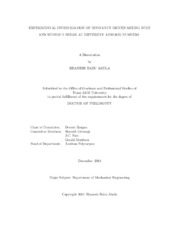| dc.description.abstract | The first objective of the present work is to study Rayleigh-Taylor instability (RTI) mixing, and turbulent velocity statistics at a high Atwood number (At = (Ph -pl)=(Ph+pl)) of 0.75. Until now, no detailed experimental results were available at this Atwood number. The second objective is to study the mixing growth rate parameter variation, velocity statistics, and turbulence behavior of combined RTI and KHI (Kelvin - Helmholtz Instability) at different Atwood numbers. In the present study, a new multi layer gas tunnel facility was built at Texas A&M University to perform the experiments. This is a convective type system where fluids with different density (air and air-helium mixture), initially separated by partitions, start to mix in a transparent acrylic test section. A new density probe was developed using hot-wire anemometry techniques to make instantaneous density measurements inside the mixing layer. This probe along with a three wire probe is used to measure instantaneous velocity components and density simultaneously. Visualization experiments are performed to measure mixing heights and growth rates. For the first time, Particle Image Velocimetry (PIV) is also implemented for measuring RTI velocity statistics at these Atwood numbers.
For the RTI experiments at Atwood number 0.75, the spike grew 1.8 times faster than the bubble, and also looked like fragmented dendrite like features rather than the classical mushroom structure. The velocity statistics measured at this Atwood number show self-similarity and scale well with the terminal bubble velocity. These scaling ratios and growth rate parameters are useful to validate existing RTI models. Combined instability experiments have shown that the initial mixing layer development is governed by KHI, and the late time mixing is governed by RTI. This transition between the two regimes is quantified through the Richardson number at four different Atwood numbers, and observed to be in between -0.8 to -2.3. In the combined instability experiments, almost two decades of inertial range scales confirming the Kolmogorov 5=3 scaling law are observed. The molecular mixing in these regimes, and the velocity PDF evolution during the transition are discussed. | en |


